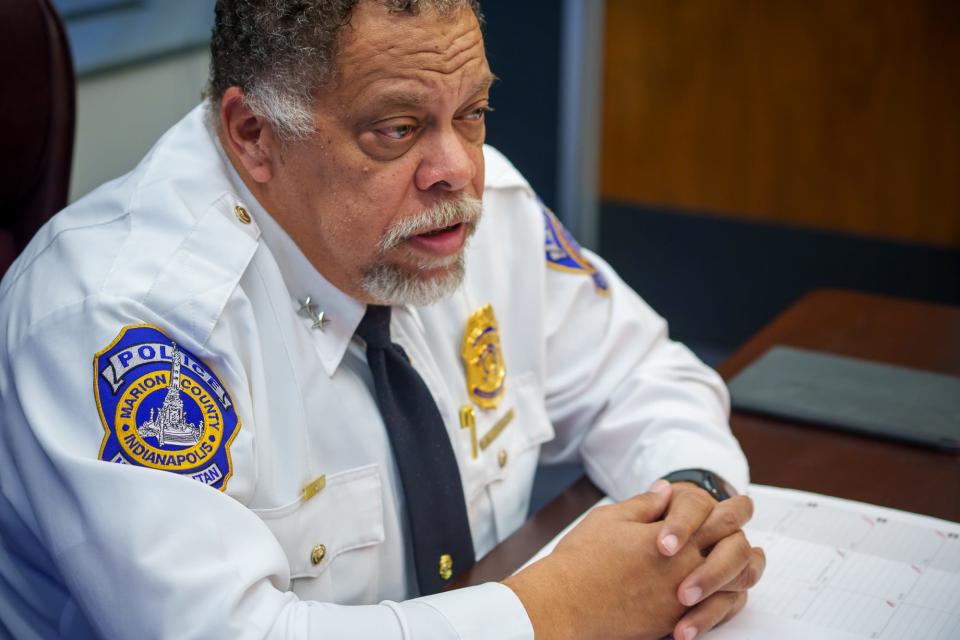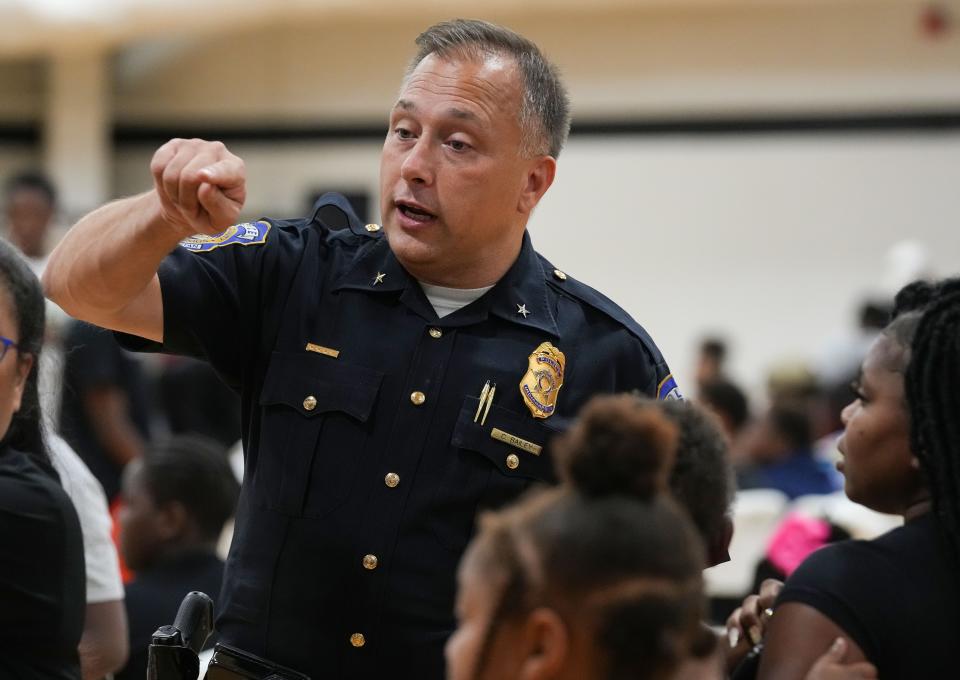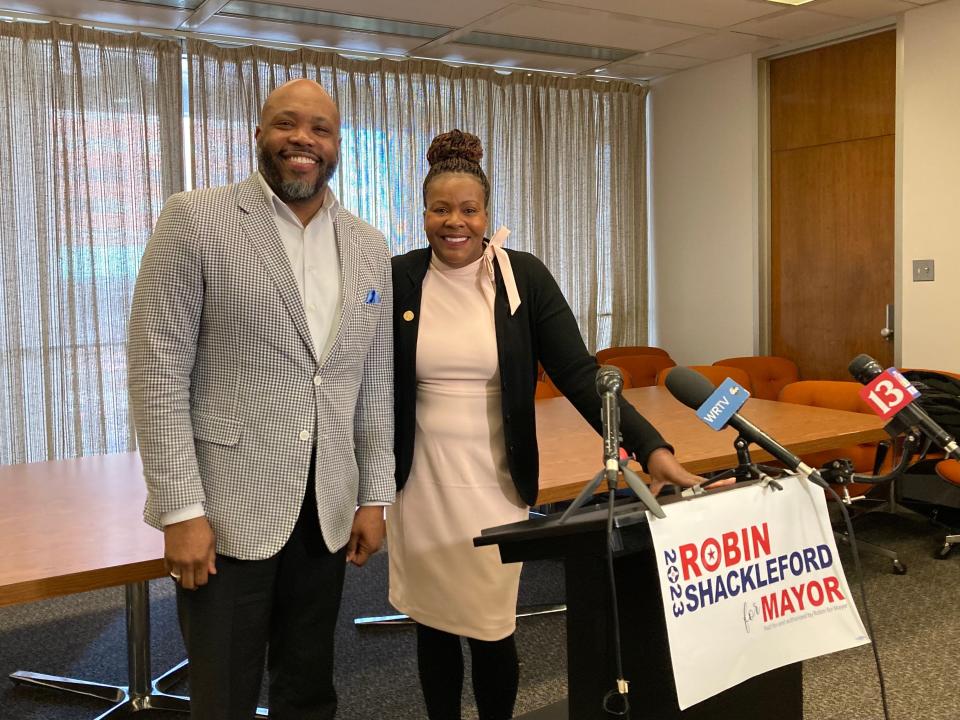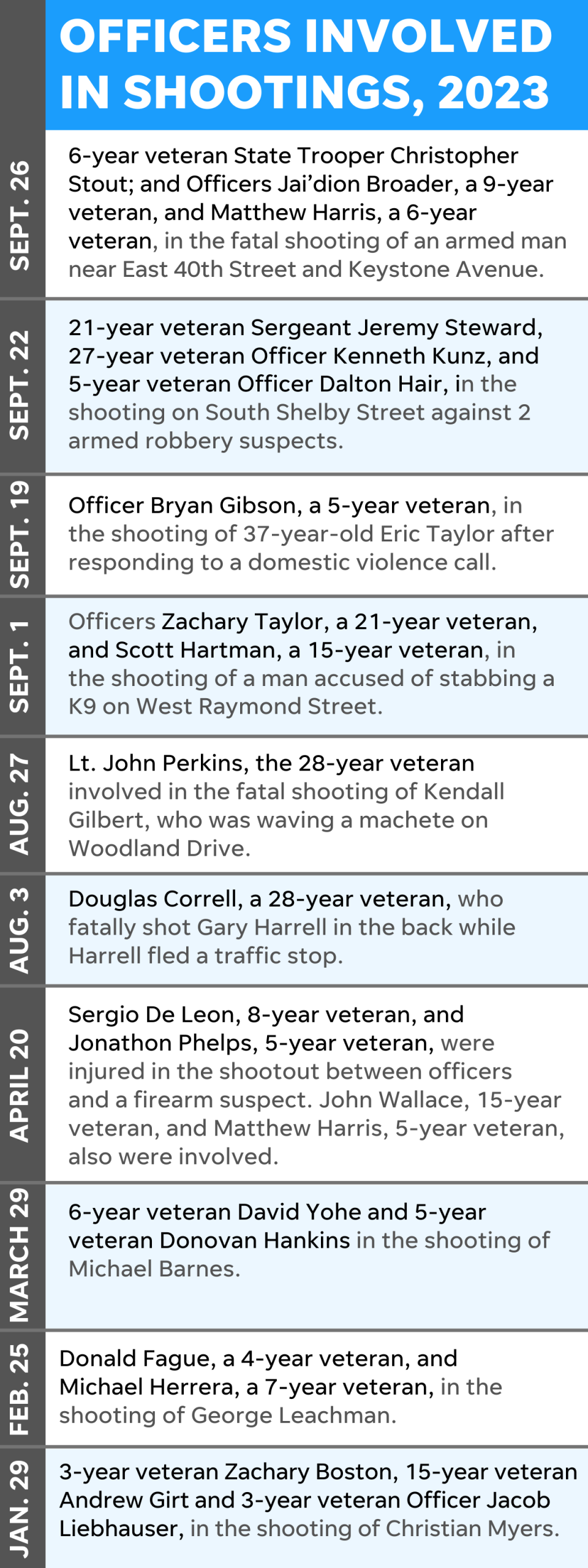Indianapolis police shootings highest in years. What is going on?
Black ministers had a strong demand: Indianapolis' top cop must resign.
The Concerned Clergy of Indianapolis said they lost faith in Police Chief Randal Taylor after a Black motorist stopped for a traffic violation was fatally shot running away from an officer Aug. 3.
Six more people were shot by city police in the eight weeks that followed — and a total of 11 in the first nine months of the year. All but one of them are Black.
The repeated use of deadly force has invoked apathy for some people, who accept it as unavoidable in this era of increased gun ownership and strained relations between residents and the people sworn to protect them.
Members of the Indianapolis Metropolitan Police Department, who have been shot twice this year on city streets, say they also have had enough.
“We are fed up with it. The community should be fed up with it,” Assistant Chief Chris Bailey said after the April shooting.
What’s driving the rash of police shootings this year isn’t clear. Police, politicians and community advocates have differing opinions. Experts say a reason can’t be known without scrutinizing each case.

“You would have to analyze the data to see what, if any, patterns emerge from these shootings,” said Jon Shane, professor of police policy and practice at John Jay College of Criminal Justice.
While debate continues about what may be driving the uptick, the fact remains Indianapolis police officers have killed people this year at a level not seen since 2016.
Chief Taylor told IndyStar in an interview he cannot recall a time in his 36-year career in law enforcement that so many police shootings have happened in such a short period.
"It's definitely concerning," he said.
Fewer police shootings in other cities
Of the 11 people Indianapolis police have shot in the first nine months of the year, six have died. In 2022, police shot four people, one fatally. Officers in six additional incidents fired their guns but did not strike anyone.
“It's a very rare occurrence," Stephanie Whitehead, a criminal justice professor at Indiana University East, said about the frequency of shootings since August.
Not included in the total are three people who were shot by state troopers in the city. Within a week in May, Indiana State Police troopers shot two people in separate incidents. In February, a state trooper shot a man being tracked in a gun and drug investigation.
More people have been shot by Indianapolis police this year than by other agencies in cities with roughly similar population sizes.
San Francisco police, for example, have shot six people since 2022.
Indianapolis surpassed Columbus, Ohio, a slightly larger city, where police have shot 10 people so far this year. Six were shot last year, according to the police department.
Indianapolis also stands out compared to several smaller Midwestern cities.
Louisville police have shot six people this year and three in 2022. Milwaukee police have shot almost as many people in 2022 and 2023 as Indianapolis police did this year alone.
In Minneapolis, police shot three people last year. There have been no officer-involved shootings so far this year, according to the police department.
Grasping for an explanation
Absent a closer look at each case, Shane, the John Jay College professor, said the increase of police shootings in recent weeks may be coincidental.
“More likely than not what happened is, you just had a spate of difficult situations arising all at the same time," Shane said.
But data show police killings have generally increased in recent years when compared with the past decade, according to the nonprofit Mapping Police Violence. The increase appears to be continuing well into 2023, the organization said in its database.
The deadly use of force has particularly impacted Black Americans. Black people were three times as likely to be killed by police than white people in the United States last year, the nonprofit stated.
Rep. Earl Harris Jr., D-East Chicago, and chair of the Indiana Black Legislative Caucus, said the group is "heartbroken" over the numerous police shootings, and noted Black Americans face higher rates of injury or death when interacting with officers.
Permitless carry, illegal guns blamed
Harris also faulted the state's permitless carry law. It has undermined an officer's ability to quickly determine whether a person is legally carrying, he said in a statement.
"Police officers must assume anyone they pull over or interact with is armed and must be prepared to defend themselves and their fellow officers if necessary," Harris said.
Past coverage: 'We’re all at greater risk.' How the end of handgun permits could impact violent crime
State Police Superintendent Douglas Carter cited similar concerns about officer safety to lawmakers while the constitutional carry legislation was still in bill form. The law has been on the books just over a year, and its impact on crime has not been measured.
What police are seeing on the streets is a continuous flow of illegal guns, they say.
Bailey, the assistant chief, pointed to a record number of firearms seized this year by the Indiana Crime Guns Task Force, a group of state and federal officials and law enforcement officers from Marion and surrounding counties that was created in 2021 to trace guns tied to violent crimes.
"Lots of people have guns. Lots of people are doing bad, violent things, and our officers and troopers put themselves in harm's way each and every day to take them off the streets so that they don't harm anybody else," Bailey told reporters Sept. 26 after 42-year-old Darmon Graves Jr. was killed in a shootout with members of the task force in the city's latest police shooting.
Chief Taylor gave a similar remarks to IndyStar, attributing the recent police shootings to the decisions people made during their interactions with officers.
"It’s concerning that we would have people that are out there that would have weapons and point weapons at officers," he said. "I’m really concerned with the decisions people are making as it relates to their action with officers and the poor choices they’re making, more than anything."

Officers are also increasingly facing guns fixed with illegal devices that essentially transform the firearm to function like a machine gun.
In January, three Indianapolis officers shot 22-year-old Christian Myers after police say he fired at them while running away in a neighborhood along Binford Boulevard. Myers was suspected of shooting the car of his child's mother the night before. When police apprehended him, they found a Glock switch nearby.
Link to mental health crisis
One fatal police shooting in August brought another layer of concern by the community about officer use of force against those experiencing mental health crises.
In that case, police responded to reports about a man making threats and encountered 40-year-old Kendall Darnell Gilbert waving a machete around a neighborhood. Gilbert's family told police he struggled with mental illness after officers had been at the home several times that weekend. In each case before the deadly encounter, officers determined he was not a threat.
Roughly 2.5 hours in, police officials said Gilbert struck an officer's shield with the machete after being shocked with a stun gun. Lt. John Perkins, a 28-year veteran, fired his gun, striking him. Gilbert died at a hospital.
A former police/community liaison raised questions over the violent conclusion after witnessing and livestreaming the standoff.
“I didn't see a reason for this to end bad,” Gregory Meriweather told IndyStar at the time. “I didn't see a reason for him to end up with a bullet in him.”

It wasn't the first time community members have expressed frustration over how the city handles mental health-related calls for help.
In April 2022, Herman Whitfield III died after being tased and handcuffed face down by Indianapolis police officers while experiencing a mental health crisis. His death spurred calls from the community for changes in the city's response to people struggling with mental illness.
Since then, the city has created teams of medical professionals who will respond to certain 911 calls if a patient is in crisis and no weapons are involved. The group's aim is to lower the chances of a deadly police encounter.
Three months in, the clinician response team's early days of work are starting just as the spree of police shootings began.
Clinician-led team: Indy's new 911 response team hopes to save lives with therapy, not police
Shootings at center of police department budget talks
Outcry from community members about the use of deadly force by officers came to a head in September at a city budget hearing for the police department.
Some residents have opposed increasing the department's budget, arguing that other types of first responders are better equipped to handle mental health calls.
Bailey has previously said police have shouldered mental health-related calls for years, estimating only 20% of the police department’s calls are related to actual law enforcement issues, and the remaining 80% stem from issues not built for officers.
The city has continuously poured millions into the police department since 2016, the last time police shootings reached close to this year’s levels. The proposed 2024 budget set another record for Indianapolis’ police, topping $323 million for the department.
Police leaders and other groups said they need more resources to address the department's staffing shortage and violent crime. The city's budget funds 1,743 police department employees, with federal grant dollars allowing for 100 more. But as of mid-August, the department only had 1,542 sworn officers.
Further placing a strain on staffing, albeit a small one, is the requirement for officers to go on leave for 30 days after a deadly use of force. After the 30 days are up, the officer are put in an administrative job or recommended for termination.
Before they're returned to the force, they must pass a mental evaluation and executive staff will review the shooting. The police chief will then decide whether to return the officer to their regular job or keep them on administrative duty while the investigation continues.

As of Sept. 26, nine Indianapolis police officers were on administrative leave or duty because of police shootings.
Among the officers who have been identified in police shootings this year, they average just shy of 11 years of experience on the force. The lowest was three. The highest, 28 years.
Mayoral candidates weigh in
Indianapolis' mayoral candidates have opposite views on whether the police shortage is contributing to the number of officer shootings.
Democratic Mayor Joe Hogsett, whose tenure is now marred by some of the highest numbers of police shootings in recent history, said there's "no evidence" staffing challenges have caused the increase. He said in a statement that each person shot by police this year has been armed, which he says reflects "the high level of danger IMPD officers face when entering these circumstances."
Hogsett's Republican challenger, Jefferson Shreve, said the officer shortage is to blame, along with the mayor.
"This record number of (fatal) police action shootings is emblematic of the chaos that we are still wrestling with in parts of our city," he said. "It's another metric that reflects that our officers are stretched thin."
Whether the shootings were an appropriate use of force or not will be determined by the review system, Shreve added.
When asked if he supports Taylor's resignation, Shreve said, "I think that’s got to be the sitting mayor’s decision." Hogsett, who took office in 2016 and hired Taylor, reiterated his support for the chief.
Shreve said that he thinks the 2022 law eliminating the permit requirement to carry handguns in Indiana played a role in the rise in fatal police shootings but is not solely to blame.
"We took a tool away," Shreve said, because police cannot check if a gun is registered. "It’s a tool I would not have taken away. That’s not the only reason."
Chief says accountability needed on all sides
Police shootings account for a tiny fraction of the 600,000 calls officers have responded to this year, Taylor said.
"Everyone wants to hold the police accountable, and I've got no problem with that," Taylor said. "But at some point, the community has got to find a way to hold their own selves accountable for their actions as well."
Taylor has, at least publicly, ignored calls for his resignation.
Reporters Ko Lyn Cheang, John Tufts and Jake Allen contributed to this article.
Contact reporter Sarah Nelson at 317-503-7514 or sarah.nelson@indystar.com. IndyStar reporter Kristine Phillips can be reached at (317) 444-3026 or at kphillips@indystar.com.
This article originally appeared on Indianapolis Star: Indianapolis police shootings highest in years. What is going on?

